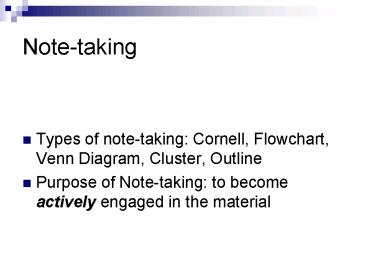Notetaking - PowerPoint PPT Presentation
1 / 26
Title:
Notetaking
Description:
Types of note-taking: Cornell, Flowchart, Venn Diagram, Cluster, Outline ... Venn Diagrams. Kibbing Bid. Helgis Bid. Hidden wiring $15,500. 7-yr. warranty. Both. Adj. ... – PowerPoint PPT presentation
Number of Views:46
Avg rating:3.0/5.0
Title: Notetaking
1
Note-taking
- Types of note-taking Cornell, Flowchart, Venn
Diagram, Cluster, Outline - Purpose of Note-taking to become actively
engaged in the material
2
(No Transcript)
3
Cornell System
4
Cornell System
- Many business writers favor this 2-column form.
- Write your notes in one column.
- Later use the other column to list key words,
review, or focus your notes.
5
Cornell System
6
Flowcharts
7
Flowcharts
- Use a flowchart to take notes about a cycle or
process. - Draw a box for each part or step and add arrows
that show the flow of events or information. - A flowchart eliminates jotting down many words.
8
Flowcharts
- Production
- Management
- Team
- Change
- quality control
- procedures
- 2) Retrain
Quality Task Force Review process and recommend
Executive Committee Identifies FDA problem areas
Sales and PR staff Contact customers and media
9
T-Bars
- Draw a T-Bar and label the two sides pros/cons,
before/after, similarities/differences,
problems/solutions, reasons for
refusal/alternative suggestions, and so forth. - Create labels appropriate to your situation.
10
T-Bars
11
(No Transcript)
12
Venn Diagrams
13
Venn Diagrams
- Use the Venn diagram to compare two topics.
- Draw two overlapping circles as shown.
14
Venn Diagrams
Kibbing Bid
Helgis Bid
Both Adj. sound Monitoring possible
Partly hidden wiring 14,850 3-yr. warranty
Hidden wiring 15,500 7-yr. warranty
15
Clusters
- A cluster is excellent for brainstorming. It
also works when the speakers do not follow a
sequence. - Begin with a key word, name, topic, or phrase.
- Then record or cluster the details around it.
Add branches that relate to each other and the
central word. - Later use markers to color-code or emphasize
important concepts.
16
Cluster
17
5 Ws Chart
- The 5 Ws Who? What? Where? When? Why? (and
How?) identify basic information about a subject. - These questions ensure that you will always have
the facts you need.
18
5 Ws Chart
19
Outline
20
Outline
- When you have an agenda, a text, a syllabus, or a
memo that indicates the ideas that will be
covered, use it to create an outline before you
attend the meeting, class, or other event. Show
importance by indenting.
21
Outline
- Topic Contaminated Water
- Problem in Walland affects our plant there
- Ill employees
- Solutions
Leave white space between items
22
Topic List
- When you dont know what topics will be
discussed, consider using a topic list. - The topic list also works well for a group.
- Groups often do not follow a logical sequence and
may pop back or pop forward to a topic.
23
Topic List
- Topic HR system
24
Learning styles and Note-taking
- Verbal-linguistic rewrite important ideas or
summaries - Logical-mathematical organize main points in
outline format, use charts , graphs - Bodily-kinesthetic make notes taking as physical
as possible, use file cards
25
Learning style ( cont)
- Visual spatial use colored pens, clusters,
diagrams - Interpersonal use study group to discuss notes,
review notes with study partner - Intrapersonal schedule quiet time to review
notes and reflect on notes
26
Learning styles (cont)
- Musical play music while you read notes, create
a chant form note material - Naturalistic read or rewrite notes outside or
while listening to nature CD































